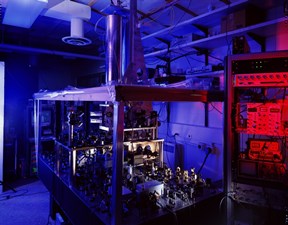



Date:13/02/16
 A new optical single-ion clock in Germany has now dethroned JILA's optical lattice atomic clock as the world's most accurate timepiece ever built.
A new optical single-ion clock in Germany has now dethroned JILA's optical lattice atomic clock as the world's most accurate timepiece ever built.
With an unprecedented level of accuracy, the optical single-ion clock works by measuring the vibrational frequency of ytterbium ions as they swing back and forth hundreds of trillions times per second.
The ytterbium ions are trapped within an optical "web" of laser beams that allows physicists to count the number of "ticks" per second, determining time so accurately that the single-ion clock won't gain or lose a second in several billion years.
Prior to the development of the ytterbium-ion clock, the most accurate time-keepers were made of caesium. These optical lattice atomic clocks contained a "pendulum" of atoms that are excited by microwave radiation. The official definition of the second is based on these clocks.
According to the most accurate caesium clocks, one second is the time that elapses during 9,192,631,770 cycles of the radiation produced by the transition between two levels of the caesium atom.
However, when it comes to defining time, one can never be too accurate. Scientists all over the world have been attempting to perfect their optical atomic clocks, and so the need to redefine the "second" is becoming important.
Now, Germany's Physikalisch-Technische Bundesanstalt (PTB) has ousted the most accurate caesium clocks by building their own optical atomic clock, which is 100 times more accurate.
The clock is used in navigation for determining the location of spacecraft, satellites, ballistic missiles, aircraft, submarines and vehicles via satellites.
Scientists create most accurate atomic clock in the world
 A new optical single-ion clock in Germany has now dethroned JILA's optical lattice atomic clock as the world's most accurate timepiece ever built.
A new optical single-ion clock in Germany has now dethroned JILA's optical lattice atomic clock as the world's most accurate timepiece ever built.With an unprecedented level of accuracy, the optical single-ion clock works by measuring the vibrational frequency of ytterbium ions as they swing back and forth hundreds of trillions times per second.
The ytterbium ions are trapped within an optical "web" of laser beams that allows physicists to count the number of "ticks" per second, determining time so accurately that the single-ion clock won't gain or lose a second in several billion years.
Prior to the development of the ytterbium-ion clock, the most accurate time-keepers were made of caesium. These optical lattice atomic clocks contained a "pendulum" of atoms that are excited by microwave radiation. The official definition of the second is based on these clocks.
According to the most accurate caesium clocks, one second is the time that elapses during 9,192,631,770 cycles of the radiation produced by the transition between two levels of the caesium atom.
However, when it comes to defining time, one can never be too accurate. Scientists all over the world have been attempting to perfect their optical atomic clocks, and so the need to redefine the "second" is becoming important.
Now, Germany's Physikalisch-Technische Bundesanstalt (PTB) has ousted the most accurate caesium clocks by building their own optical atomic clock, which is 100 times more accurate.
The clock is used in navigation for determining the location of spacecraft, satellites, ballistic missiles, aircraft, submarines and vehicles via satellites.
Views: 492
©ictnews.az. All rights reserved.Similar news
- Azerbaijani project to monitor disease via mobile phones
- Innovative educational system to be improved under presidential decree
- NTRC prolongs license of two TV and radio organizations for 6 years
- Azerbaijan establishes e-registry for medicines
- Azerbaijani museum introduces e-guide
- Nar Mobile opens “Nar Dunyasi” sales and service center in Siyazan city
- International conference on custom electronic services held in Baku
- OIC secretary general to attend COMSTECH meeting in Baku
- Azerbaijan develops earthquake warning system
- New law to regulate transition to digital broadcasting in Azerbaijan
- Azerbaijani State Social Protection Fund introduces electronic digital signature
- Intellectual traffic management system in Baku to be commissioned in December
- Tax Ministry of Azerbaijan started receiving video-addresses
- World Bank recommends Azerbaijan to speed up e-service introduction in real estate
- Azerbaijan to shift to electronic registration of real estate





















